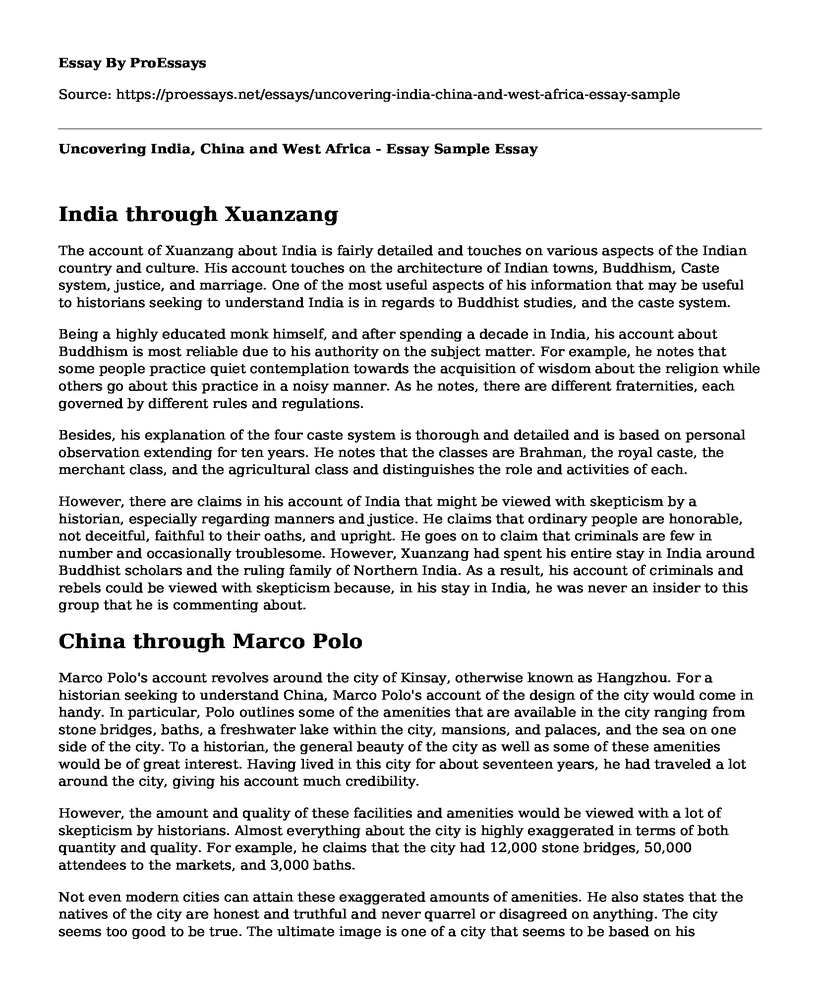India through Xuanzang
The account of Xuanzang about India is fairly detailed and touches on various aspects of the Indian country and culture. His account touches on the architecture of Indian towns, Buddhism, Caste system, justice, and marriage. One of the most useful aspects of his information that may be useful to historians seeking to understand India is in regards to Buddhist studies, and the caste system.
Being a highly educated monk himself, and after spending a decade in India, his account about Buddhism is most reliable due to his authority on the subject matter. For example, he notes that some people practice quiet contemplation towards the acquisition of wisdom about the religion while others go about this practice in a noisy manner. As he notes, there are different fraternities, each governed by different rules and regulations.
Besides, his explanation of the four caste system is thorough and detailed and is based on personal observation extending for ten years. He notes that the classes are Brahman, the royal caste, the merchant class, and the agricultural class and distinguishes the role and activities of each.
However, there are claims in his account of India that might be viewed with skepticism by a historian, especially regarding manners and justice. He claims that ordinary people are honorable, not deceitful, faithful to their oaths, and upright. He goes on to claim that criminals are few in number and occasionally troublesome. However, Xuanzang had spent his entire stay in India around Buddhist scholars and the ruling family of Northern India. As a result, his account of criminals and rebels could be viewed with skepticism because, in his stay in India, he was never an insider to this group that he is commenting about.
China through Marco Polo
Marco Polo's account revolves around the city of Kinsay, otherwise known as Hangzhou. For a historian seeking to understand China, Marco Polo's account of the design of the city would come in handy. In particular, Polo outlines some of the amenities that are available in the city ranging from stone bridges, baths, a freshwater lake within the city, mansions, and palaces, and the sea on one side of the city. To a historian, the general beauty of the city as well as some of these amenities would be of great interest. Having lived in this city for about seventeen years, he had traveled a lot around the city, giving his account much credibility.
However, the amount and quality of these facilities and amenities would be viewed with a lot of skepticism by historians. Almost everything about the city is highly exaggerated in terms of both quantity and quality. For example, he claims that the city had 12,000 stone bridges, 50,000 attendees to the markets, and 3,000 baths.
Not even modern cities can attain these exaggerated amounts of amenities. He also states that the natives of the city are honest and truthful and never quarrel or disagreed on anything. The city seems too good to be true. The ultimate image is one of a city that seems to be based on his imagination. Besides, there is no mention of the Great Wall of China that is a landmark of this country as well as the mention of the culture of tea drinking. The omission of these landmarks in the Chinese landscape and culture brings doubt as to whether Polo had traveled around China at all.
West Africa through Ibn Battuta
In his account, Battuta describes in detail the culture and daily activities of the people of Mali in West Africa. A historian seeking to understand West Africa would be interested in some of the accounts on how Islam was practiced by the natives of Iwalatan province in West Africa. One of the things that emerge is that though Muslims, the people have a particular culture where men and women have lovers outside marriage. Moreover, women do not veil themselves like those of other regions in the Muslim world.
Within Mali city, the Battuta describes in detail the daily religious and political practices of the people especially their humility before the king. The relationship between the people and their king is typically one between a king and his subjects. For example, he describes how the subjects knock the ground with elbows and stand with head bowed when being addressed by the king. These details would be of interest to historians.
However, historians would be skeptical about his description of black women. There is a feeling that he despises the women of the black color or he is a male chauvinist. For example, he describes that the women servants, young girls, and slave-girls of the city of Mali go in front of everyone stark naked. He also claims that all women who go into the presence of the Sultan of Mali have to be naked. He goes on to report that even the king's daughters also go about naked. Historians would be skeptical about this account because it is only the women of all ages who seem to be portrayed as savages who walk around naked everywhere.
Bibliography
Strayer, Robert W, and Eric W Nelson. Ways of the World with Sources, Volume 1: A Brief Global History. New York: Bedford/St. Martin's, 2018.
Cite this page
Uncovering India, China and West Africa - Essay Sample. (2023, Aug 17). Retrieved from https://proessays.net/essays/uncovering-india-china-and-west-africa-essay-sample
If you are the original author of this essay and no longer wish to have it published on the ProEssays website, please click below to request its removal:
- The United States (U.S.) Involvement During World War 2 Essay
- Essay Sample on Amy Beach: Revolutionary American Composer & Pianist
- Research Paper on Universities in China: Leveraging Information, Innovation and E-Learning
- Article Analysis Essay on Slavery and Abolition in the 20th Century
- Report Sample on Bill Gates' Epic Speech: 'The Next Outbreak'
- Public Health Care: Debates, Challenges & Solutions - Essay Sample
- Criminal Procedure Violations - Report Example







